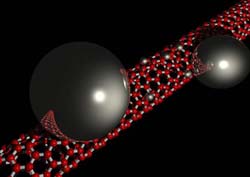Materials management deals with the research, development, manufacturing and processing of raw and industrial materials. Key aspects here are biological and medical issues, which play an increasingly important role in this field.
innovations-report offers in-depth articles related to the development and application of materials and the structure and properties of new materials.

Researchers at the Public University of Navarre and the Navarre Industry Association research centre have managed to increase by 30 to 500 % the superficial hardness and resistance to wear of metals and V5Ti alloys by means of applying nitrogen. These results could be of great use for different industrial applications in which these types of materials are employed such as in the aeronautic and biomedical sectors.
Economic losses
The wear and tear of tools and machine tools i

Wooley technique ’linchpin’ to success
Using a technique pioneered by Washington University in St. Louis chemist Karen Wooley, Ph.D., scientists have developed a novel way to make discrete carbon nanoparticles for electrical components used in industry and research.
The method uses polyacrylonitrile (PAN) as a nanoparticle precursor and is relatively low cost, simple and potentially scalable to commercial production levels. It provides significant advantages over existing

Australian scientists have developed a breakthrough low-cost, lightweight, concrete technology that is set to lower costs and speed up construction projects from residential homes to high-rise buildings.
HySSIL (High-Strength, Structural, Insulative, Lightweight) panels are manufactured using a new low energy, process developed by CSIRO Novel Materials & Processes. Dr Swee Liang Mak, who leads the HySSIL development team at CSIRO says, ’HySSIL is a revolutionary aerated cementitious (cement

For the last few years scientists at the Nanometer Consortium at Lund University have been able to make nanowires, tiny wires just a few millionths of a millimeter “thick” and made of semiconducting material of great potential in the electronics industry. Now they have managed to produce “nanotrees,” in fact tiny forests on the same scale.
This is described in an article (“Synthesis of branched ‘nanotrees’ by controlled seeding of multiple branching events”) in the journal Nature Materials,

First demonstration that ’MAP’ laser technique can be used non-destructively on biomaterials; potential applications range from medical research to fiber optics
Researchers in the laboratory of Boston College Chemistry Professor John T. Fourkas have demonstrated the fabrication of microscopic polymeric structures on top of a human hair.
Fourkas, in collaboration with Boston College Physics Professor Michael J. Naughton and Professors Malvin C. Teich and Bahaa E. A.

In a development that brings the promise of mass production to nanoscale devices, Lawrence Berkeley National Laboratory scientists have transformed carbon nanotubes into conveyor belts capable of ferrying atom-sized particles to microscopic worksites.
By applying a small electrical current to a carbon nanotube, they moved indium particles along the tube like auto parts on an assembly line. Their research, described in the April 29 issue of Nature, lays the groundwork for the high-throughput